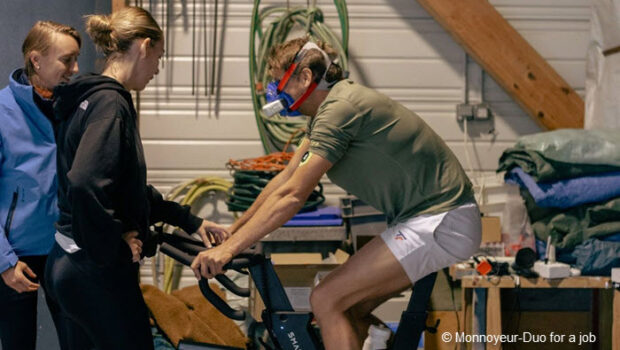A new study on the impact of offshore racing to the human body is reviewing data involving 15 of the 40 competitors from the 2024-25 Vendée Globe. Racing in the 60-foot IMOCA, the study is learning what happened for the 2+ months during this solo, non-stop, round the world race.
Called the IMOCA Human Performance Project, the research is being carried out by the Swiss bio-engineering specialist Bérénice Charrez who is working with IMOCA and with the University of Caen Normandy on the first full-scale study of Vendée Globe sailors.
“Although the discoveries, or most of them, were expected, I think the whole sailing community, or at least the skippers that were part of it, were surprised by the numbers they saw,” says Charrez. “At least it will raise awareness on how important it is to think more about their physiology.”
An accomplished sailor herself and triathlon competitor, Charrez, 32, was racing in the 2023 Ocean Race VO65 Sprint Cup with Team Viva México when it struck her that unlike triathlon, for example, there was no monitoring of any kind to see how sailors’ bodies were performing under the stress of competition.
“There was pretty much nothing that was being monitored and optimized for performance with existing tools,” she recalled.
Having previously worked with cycling teams and fire fighters, Charrez proposed the first ever study of Vendée Globe sailors of this kind and, with IMOCA’s backing, set about gathering information from the 15 candidates.
In the days leading up to the race start, she carried out a comprehensive series of measurements and assessments which ranged from basic medical measurements like weight, height, and body composition to measurements of muscle girth in thighs, calves, and arms.
The skippers also did VO2 Max tests to understand how many calories they burned during exercise, their sweat patterns, and their overall physical conditioning. Charrez also tested hand-grip strength and jump heights.
During the race, the skippers wore a Garmin watch that continuously measured biometric data – heart rate, blood oxygen, blood pressure, skin temperature, and so on. An environmental sensor in the cockpit, developed at the University of Caen, measured elements like temperature, humidity, and noise so Charrez could compare the sailors’ psychological state at any point with the environment they were living in at the time.
She also studied sleep patterns and, with three of the skippers, carried out a daily psychological questionnaire that asked them about perceived stress, perceived fatigue, their state of mood, and how much they were eating and drinking.
“I had a lot of hypotheses because I am a sailor myself and there were things I was expecting and things I wanted to confirm scientifically,” said Charrez, who is still working her way through the data. “I guess the biggest hypothesis I had was that offshore sailors, and especially sailors that race for so long, are more comparable to astronauts than typical athletes.”
Among the first results was a surprising finding that sailors lose height – between one and one-and-a-half centimeters – during a Vendée Globe. Charrez is not sure why, but thinks it may be related to the compression element of being cramped in a cockpit for weeks on end and the consequent loss of flexibility.
“It was interesting that it was consistent with all the sailors,” she said, adding that the lost height would be quickly regained once back on land.
Another surprise was that on average there was no significant weight loss among Vendée Globe sailors, despite the rigors of the race and a diet of mainly freeze dried food. There were some outliers – a sailor who lost a massive eight kilos, or 10% of body mass, for example – but it seems that most competitors and their shore teams had come up with the right nutritional mix for the race as a whole.
On the issue of balance, a simple walking test carried out immediately after the sailors hit the dock – placing one foot in front of the other, but with the heel of the advancing foot touching the toe of the placed one, and with eyes closed – produced results directly comparable to astronauts. They couldn’t do it…
Muscle atrophy, meanwhile, saw big changes with loss of girth in muscles in the thigh and calves of up to 10%. There was also loss of girth in biceps – a surprising finding given the amount of work sailors do on the pedestal winch, grinding in sails.
“It seems like they are less active than what we thought,” commented Charrez. “Even when you spend time working the winch, there is only so much time that you are doing it in a day and the rest of the time you are sitting down.”
Charrez has yet to analyze the data from the biometric and environmental sensors and from saliva and urine samples taken before and after the race. These could shed light on hormonal changes and the effects of sleep deficiency and dehydration.
Charrez is planning to work on other races and says it’s easy to see how the results of this study can help improve sailors’ performance.
“In recovery after the race, for example, they can leverage this information to recover better, but also use it to prepare better,” she reports. “That comes with optimizing nutrition and food plans and hydration as well. But also it will be interesting in the future to assess what kind of muscle fiber the different sailors have to see if a certain type of fiber is more prone to atrophy.”
With no such study previously done, the 10th edition of the race hopes to provide information to help the sailors better prepare for the rigors of offshore racing.
Source: Ed Gorman, IMOCA
SCUTTLEBUTT News Link !
DemirHindiSG 14 Mayıs 2025-18:09







